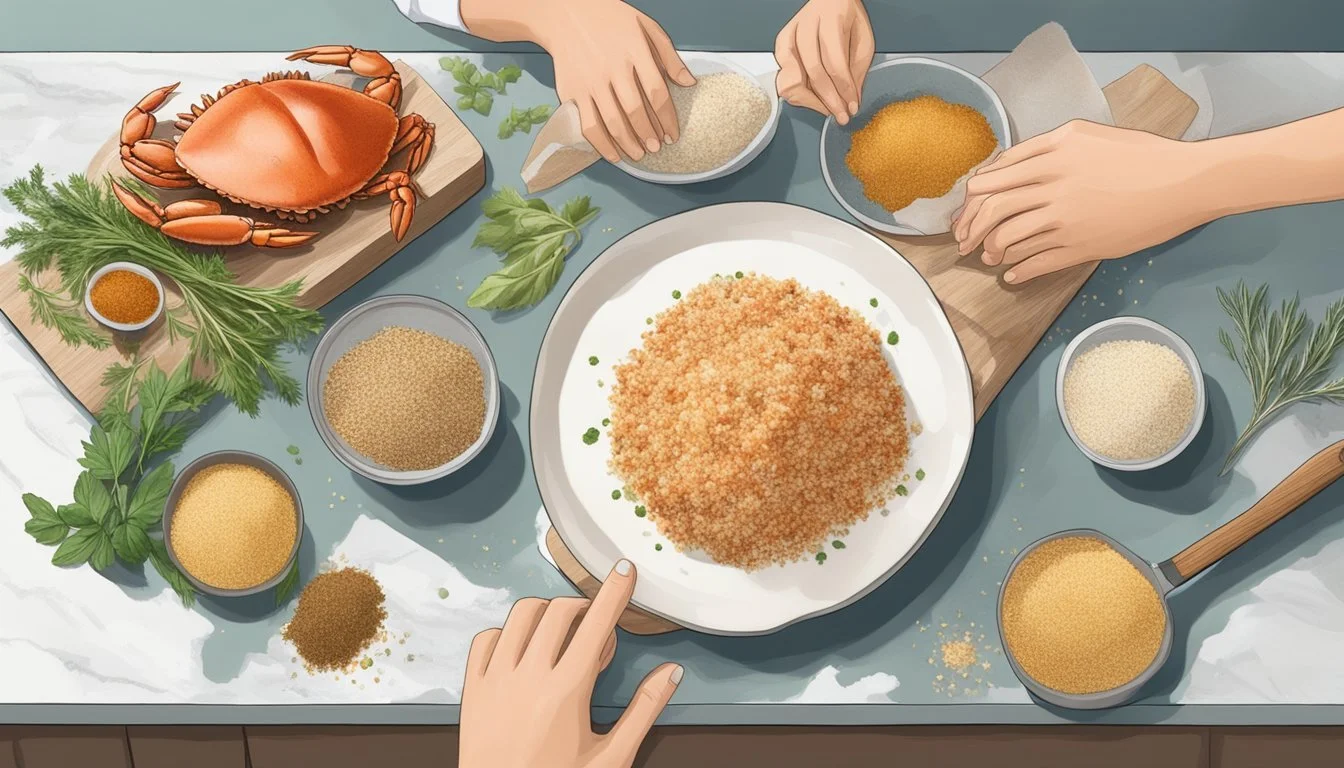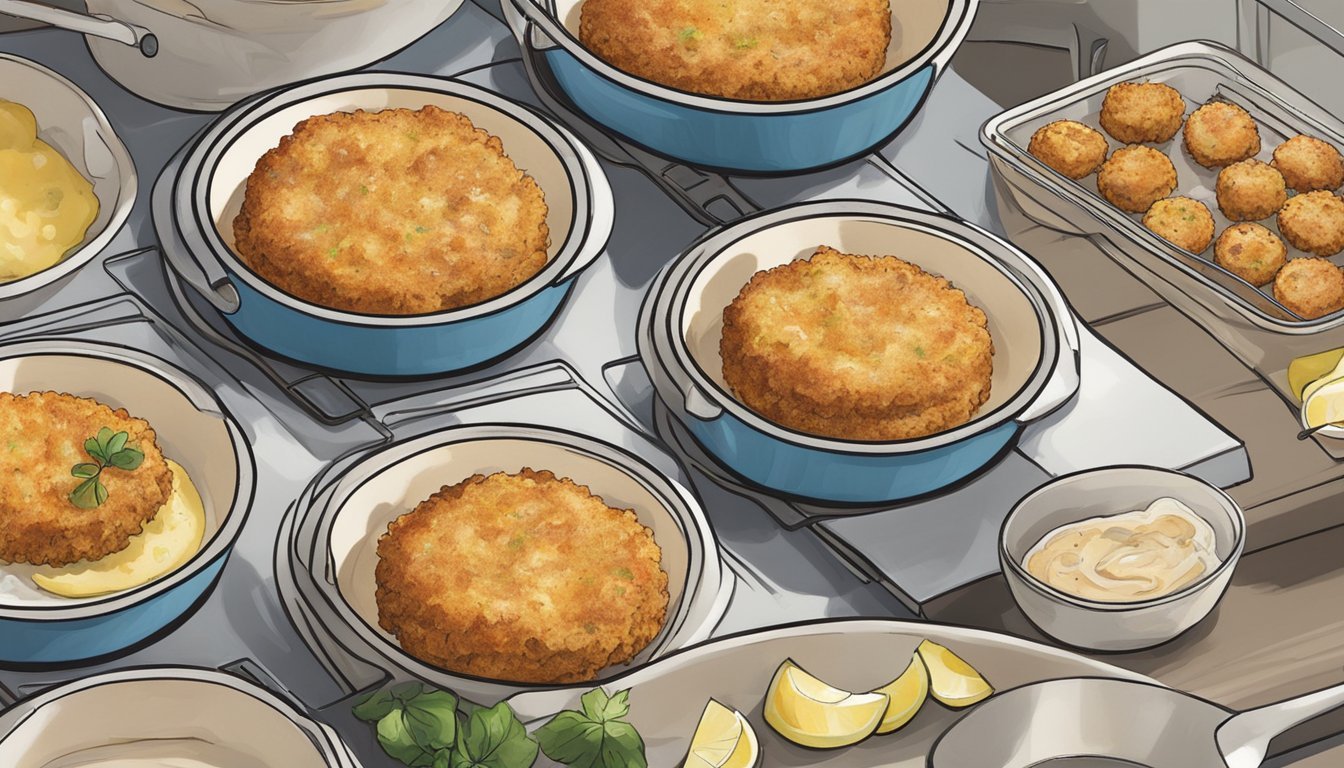How Long Do Gluten-Free Crab Cakes Last?
Storage Tips & Shelf Life
Gluten-free crab cakes are a delicious and convenient option for those avoiding gluten. Properly storing these seafood delights ensures their longevity and safety. Typically, gluten-free crab cakes can last up to three days in the refrigerator if they are stored in an airtight container.
For longer storage, freezing is an effective option. Frozen gluten-free crab cakes can be kept for up to three months. When ready to enjoy, they should be thawed in the refrigerator before reheating or cooking to maintain their texture and flavor.
Understanding how to store gluten-free crab cakes properly helps maintain their taste and safety. Whether made from scratch with fresh ingredients or reheated from frozen, these seafood treats can be enjoyed multiple times when stored correctly.
Understanding Gluten-Free Crab Cakes
Gluten-free crab cakes are an excellent alternative for those with gluten intolerance or celiac disease. They offer the same delicious experience without compromising on taste or texture.
Key Gluten-Free Ingredients
To make gluten-free crab cakes, it's crucial to use the right substitutes. Traditional crab cakes use wheat-based breadcrumbs, but gluten-free versions utilize alternatives like gluten-free breadcrumbs or gluten-free panko.
Using gluten-free flours and thickening agents ensures the mixture binds well. Coconut flour, tapioca starch, or almond flour are often used. The binding and texture are maintained without introducing gluten.
For flavor and seasoning, Old Bay seasoning remains popular. Fresh crab meat, egg, and mayonnaise are typically included. Many recipes may also add Dijon mustard, lemon juice, and fresh herbs like parsley.
What Distinguishes Gluten-Free Crab Cakes
What makes gluten-free crab cakes different is primarily their choice of binding and coating ingredients. Regular crab cakes use wheat flour or breadcrumbs, which are replaced with gluten-free alternatives.
The cooking methods for gluten-free crab cakes are similar to traditional ones. They can be baked, pan-fried, or even air-fried, accommodating various dietary preferences. The texture and flavor profiles, when done correctly, closely mimic the traditional version.
Preparation tip: Chilling the mixture is vital for holding the shape while cooking. It also helps the flavors meld together, providing a rich taste.
Gluten-free crab cakes are a versatile dish, perfect for those wanting to enjoy seafood without gluten-related issues.
Selecting Quality Ingredients
When creating delicious gluten-free crab cakes, the quality of the ingredients is paramount. Key points to consider include the freshness and type of crab meat used, as these factors greatly influence the final taste and texture.
Importance of Fresh Crab
Fresh crab meat is essential for the best flavor and texture in crab cakes. Fresh crab should have a sweet, briny aroma and firm flesh. It is recommended to use fresh crab meat within 3-5 days of purchase.
Signs of poor quality include a fishy smell or mushy texture, which can negatively impact the dish. Using fresh crab ensures the natural flavors shine, enhancing the enjoyment of the crab cakes.
Understanding Crab Meat Varieties
Crab meat comes in various types, each offering different characteristics. Jumbo lump crab meat and lump crab meat are prized for their large, succulent pieces, ideal for showcasing the crab's texture. Backfin meat offers a mix of smaller pieces, providing a balance of texture and flavor.
Claw meat has a stronger flavor and is often used for its distinct taste. Additionally, some recipes may use a combination of meat types and binders like panko or almond flour to maintain the cakes' structure. Quality fillers should be chosen to complement and not overpower the crab.
Choosing the right type of crab meat based on personal preference and recipe requirements will ensure the best results in gluten-free crab cakes.
Gluten-Free Crab Cake Preparation
The preparation of gluten-free crab cakes involves creating a well-seasoned mixture and choosing between baking or frying methods to cook them. Each step ensures the cakes are delicious and maintain their structure.
Creating the Mixture
To begin, gather crushed crab meat in a bowl. Add filler like panko breadcrumbs alongside chopped parsley for freshness. Combine these with whole egg, mayonnaise, Dijon mustard, and preferably Old Bay seasoning for additional flavor.
Mix thoroughly until all ingredients are well combined. For added convenience, refrigerate the mixture covered with plastic wrap for about 30 minutes to help it firm up. This step makes shaping the cakes easier and improves their texture during cooking.
Shaping and Cooking Methods
Shape the crab mixture into round cakes, usually about 3 inches in diameter and 1 inch thick, using wet hands to prevent sticking. Depending on your preference, you may decide to bake or fry the crab cakes.
Baking: Preheat the oven to around 450°F. Place the crab cakes on a baking sheet lined with parchment paper. Lightly brush each cake with melted butter or oil. Bake for about 12-20 minutes until they are golden brown and reach an internal temperature of 165°F.
Frying: Heat 3 tablespoons of oil in a skillet over medium-high heat until it is hot but not smoking. Carefully place the cakes in the skillet and cook for about 3-5 minutes on each side, until they are crispy and golden.
Both methods yield deliciously textured and flavorful gluten-free crab cakes.
Cooking and Baking Techniques
Understanding the right cooking methods ensures gluten-free crab cakes achieve the perfect texture and flavor. Whether baked or fried, following specific techniques is crucial for delicious results.
Oven-Baking Instructions
For oven-baking, preheat the oven to 425°F (or 450°F if seeking extra browning). Line a baking sheet with parchment paper or lightly grease with oil or butter. This prevents sticking and assists with even browning. Crab cakes should be shaped into round cakes about 3 inches in diameter and 1 inch thick.
Brush each crab cake lightly with melted butter, which promotes browning and adds a subtle flavor. Place the crab cakes a few inches apart on the prepared baking sheet. Bake for 15-20 minutes, or until the edges and tops are lightly browned. The internal temperature should reach 165°F.
Chilling the crab cakes before baking for at least 30 minutes to an hour helps them hold their shape.
Stovetop Frying Guidelines
To fry gluten-free crab cakes on the stovetop, use a large skillet and heat a generous layer of oil, such as olive oil or canola oil over medium-high heat. Ensure the oil is hot before adding the crab cakes to achieve a crispy exterior.
Shape the mixture into cakes 3 inches in diameter and 1 inch thick, as with the baking method. Gently place the crab cakes into the skillet, ensuring not to overcrowd. Fry for 3-4 minutes per side until golden brown and crispy.
After frying, drain on paper towels to remove excess oil and cool slightly. Using a combination of butter and oil can enhance flavor and crispiness.
Chilling for 30 minutes in the refrigerator before frying can help them maintain their structure while cooking.
Flavor Enhancements and Pairings
The right seasonings and pairings can elevate gluten-free crab cakes to new heights. A mix of spices, sauces, and sides can provide a balanced and flavorful dining experience.
Seasonings and Spices
Old Bay seasoning is a classic choice for enhancing crab cakes. Its blend of paprika, salt, and other spices adds a distinct tangy flavor. Adding fresh lemon juice or zest can brighten the dish, while finely chopped green onions or red onions offer a mild yet sharp contrast.
Worcestershire sauce and a dash of mustard can introduce layers of depth, enhancing the natural sweetness of the crab meat. Balancing these flavors with salt and pepper ensures a well-rounded taste profile without overpowering the crab.
Sprinkling a bit of red pepper can add a nice kick, for those who enjoy a bit of heat. Integrating such spices harmonizes the subtle flavors of the crab, making each bite more enjoyable.
Condiments and Sides
Tartar sauce is a timeless condiment that pairs exceptionally well with crab cakes, thanks to its creamy texture and tangy flavor. Hot sauce is another popular option, offering a spicy contrast. For an elegant touch, lemon wedges on the side provide a burst of freshness.
When it comes to sides, a light salad with a lemon vinaigrette complements the richness of the crab cakes. Additionally, roasted red peppers or a slaw made from green onions and shredded red onion can add a refreshing crunch.
Including a dollop of mustard or a drizzle of Worcestershire sauce on the plate accentuates the earthy flavors of the crab cakes. These additions not only enhance the overall taste but also create a well-rounded and satisfying meal.
Optimal Storage Tips
Proper storage of gluten-free crab cakes ensures they remain fresh and delicious. Keep them in an airtight container to maximize shelf life and maintain flavor. Whether you store them in the refrigerator or freezer, use these tips for optimal results.
Refrigeration and Shelf Life
Refrigerate gluten-free crab cakes promptly after cooking. Place them in an airtight container to retain moisture and prevent exposure to air, which can cause spoilage. Adding a layer of plastic wrap directly on top of the crab cakes can further prevent drying out.
Stored this way, crab cakes will stay fresh for up to 3-5 days. Label the container with the date to keep track of their freshness. This helps ensure that they are consumed while still safe to eat.
Freezing for Long-Term Storage
For longer storage, freeze the crab cakes. First, allow them to cool completely. Individually wrap each cake in plastic wrap or parchment paper to prevent sticking. Place the wrapped cakes in an airtight freezer-safe container or a zip-top bag.
Label and date the container for reference. When frozen, crab cakes can last for up to three months. To reheat, thaw them in the refrigerator overnight and bake or sauté until heated through. Avoid microwaving, as this may compromise texture.
Serving Suggestions
Gluten-free crab cakes can be versatile for various dining settings. From casual weeknight dinners to elegant gatherings, these crab cakes fit seamlessly. Their pairings can enhance flavors and suit different courses and occasions.
From Casual to Elegant
For a casual meal, pair gluten-free crab cakes with a simple side salad or steamed vegetables. Adding a squeeze of fresh lemon can brighten the dish.
For more elegant presentations, consider serving crab cakes atop a bed of mixed greens with a drizzle of aioli or tartar sauce. Garnish with fresh herbs for an added touch.
If serving as an appetizer, mini crab cakes with a dipping sauce can be a delightful choice. Try offering different sauces like spicy remoulade, garlic aioli, or even a classic cocktail sauce.
Pairing with Courses and Occasions
When serving gluten-free crab cakes as a main course, consider pairing them with roasted asparagus or a quinoa salad. This adds both flavor and variety to the meal. Another option is to serve them alongside a hearty soup, such as butternut squash or tomato basil.
For lunch, they pair well with a light cucumber and dill salad. If preparing for a special occasion dinner, consider sides like truffle mashed potatoes or a sophisticated arugula and fennel salad with citrus vinaigrette.
When thinking about the occasion, crab cakes can suit a weeknight family dinner or a more formal dining experience. The key is to balance flavors and textures, ensuring the crab cakes are the star of the plate.
Avoiding Common Pitfalls
Making gluten-free crab cakes that don't fall apart involves careful preparation and technique. It's essential to prevent cracking and ensure proper moisture balance and binding.
Preventing Cracking and Crumbling
Crab cakes falling apart is a common issue due to inadequate binding agents or overmixing. Using proper binding ingredients such as eggs and gluten-free breadcrumbs can help maintain structure. Overmixing breaks down the delicate crab, leading to a mushy texture.
Refrigerating the mixture for at least 30 minutes before cooking allows the ingredients to meld. Avoid adding too much filler, which can dilute the crab flavor and compromise texture. Gentle handling during forming is crucial to keep the cakes intact.
Balancing Moisture and Binding
Crab cakes need the right moisture balance to prevent dry or overly wet textures. Excess moisture can lead to crab cakes falling apart, while too little can make them dry and crumbly. Adjusting the amounts of mayonnaise or Greek yogurt helps maintain the correct consistency.
Using a mix of binding agents, such as a combination of panko breadcrumbs and coconut flour, can help absorb excess moisture while providing structure. Experimenting with different ratios of wet and dry ingredients ensures the best results. Avoid using too many fillers, which can overwhelm the crab and affect the final texture.
Alternatives and Dietary Considerations
For those with dietary restrictions, there are several options available to modify traditional gluten-free crab cakes. Modifications may include dairy-free and keto variations, as well as substitutes for crab meat.
Dairy-Free and Keto Variations
Creating dairy-free and keto versions of gluten-free crab cakes can be achieved with a few simple substitutions. For dairy-free options, replace butter with plant-based alternatives such as olive oil or vegan butter. Ensure the binding agent used, such as mayonnaise, is also dairy-free.
Keto adaptations often involve swapping out traditional gluten-free breadcrumbs. Instead, almond flour or crushed pork rinds can be used as low-carb alternatives. These ingredients help maintain the correct texture without adding unnecessary carbohydrates.
Substitutes for Crab Meat
When real crab meat is not available or suitable, alternatives can be used. Canned crab is a convenient option and can be easily incorporated into the crab cake mixture. Make sure to drain it well to avoid excess moisture.
Imitation crab meat is another substitute, but it's essential to check labels for gluten-containing additives. For those looking for a plant-based option, hearts of palm or artichoke hearts can mimic the texture of crab meat. These alternatives work well in gluten-free crab cakes when seasoned appropriately.











